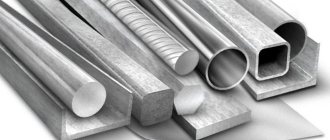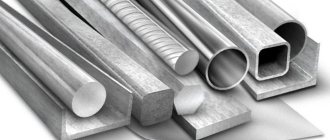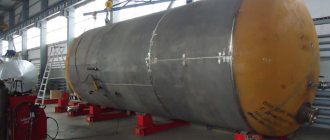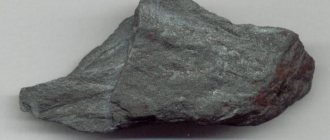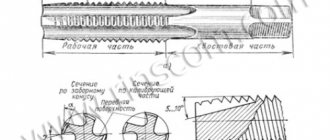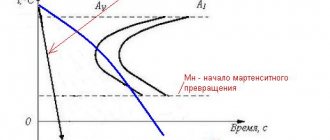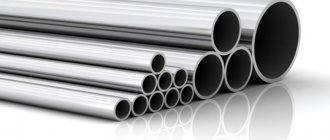04.09.2020 Author: VT-METALL
Issues discussed in the material:
- Description of structural steel
- Classification of structural steels
- Areas of application of structural steel
- Advantages and disadvantages of structural steels
- How to choose structural steel by its markings
Structural steel is in great demand today. It is indispensable in the manufacture of industrial mechanisms and the construction of building structures, as it has high strength, ductility and resistance to destruction.
This material is also used in other areas of human activity. For example, it is used to produce parts for various types of machine tools, hot-rolled ordinary products, springs, leaf springs, small fasteners and much more. However, when choosing structural steel, keep in mind that it comes in different types, each with its own physical and chemical characteristics.
Alloy structural steels
Structurally alloy steel contains several chemicals in its composition. These include manganese, nickel, and chromium. But they may not contain all three components, but only one chemical indicator. That is why the division occurred: into low-alloy steel, where the number of various additives did not exceed 2.5%; to medium alloy steel, where the impurity indicator can only be increased to 10%, high alloy steel, in which additional elements can be over 10%.
Scope of application
Structural steels are widely used in the construction of instruments, machines and units. Each brand is intended for the manufacture of certain structures, which will then be involved in the assembly of a machine or unit. Alloy alloys are used for the production of:
- springs, spring bands and coil springs - grade 60С2(A);
- critical springs and springs operating at elevated temperatures – 50ХФА (ХГФА);
- large and heavily loaded springs and springs - 60C2XA;
- splined rollers, bushings, spindles, couplings – 40Х-50Х;
- parts operating at high speeds and under heavy loads - 18ХГТ, 20ХГР;
- wear-resistant, high-strength and critical elements - 40ХС, 40ХФА;
- turbines, shafts, fasteners operating at elevated temperatures - 35ХМ.
These are examples of the use of specific grades of alloys. Separation into groups also helps to determine which structural compositions are used for what.
Low alloy structural steel
Low-alloy steel has found its application in the production of cars, rolling stock, locomotives, and in equipment for agricultural and industrial purposes. Any products made from low-alloy steel can withstand very large and heavy loads. They don't have any restrictions.
For alloy steel, the markings can be as follows: two numbers (carbon content), letters without numbers (alloying element), a letter and a number (alloying element as a percentage) and a letter at the end of the marking (an indicator of very high quality steel).
Additional classification of structural steel
The following categories of steel are widely used in industry:
- Alloyed structural steels. They have the greatest structural strength due to the addition of alloying elements.
- Heat resistant. They are characterized by a high operating temperature and are used for the manufacture of boilers, steam pipelines, as well as in various industries where elevated temperature is a constant factor. To impart heat resistance, steel is alloyed with additions of chromium, vanadium or molybdenum.
- Bearing. The presence of high local loads places increased demands on steel. Bearing steel is alloyed with chromium to provide high static load capacity.
Carbon structural steels
Carbon structural steel can also be divided into several conventional varieties: automatic, construction and boiler. Fasteners are made from automatic steel. It is not suitable for welding work, and all parts are processed on special machines. Boiler steel is needed for the production of boilers, vessels and other containers that are designed to withstand extremely high temperatures. Engineering steel is used in the production of automotive equipment.
Carbon steel may have the following marking: art. (steel designation), SP/PS/KP (degree of deoxidation), letter G (manganese - high content). An example is steel 08PS, St2ps, St3sp5, St20, St35, St40, St45, St3ps and others.
Selection of structural steel by its marking
Structural metals are marked according to a complex system that includes many designations. Let's take a closer look at it.
Carbon steel of ordinary quality is standardly designated by a combination of the letters “St” and numbers from 0 to 6 - they reflect the grade number. Then there is a description of the degree of deoxidation: in calm steels - “sp”, semi-quiet steels - “ps” and boiling steels “kp”. Moreover, in structural steel grade 0, the degree of deoxidation is not indicated, but the phosphorus content in it is reflected (no more than 0.07%) , sulfur (no more than 0.06%) and carbon (no more than 0.23%). Grades from 1 to 6 can be semi-calm, and from 1 to 4 – boiling. The share of C, Mn, Si, S, P is strictly prescribed in them.
According to GOST 1050–88, the marking of high-quality carbon steels includes a two-digit number indicating the concentration of carbon in it (in hundredths of a percent): 0, 8, 10, 20, ... 60. From this designation it is obvious that, for example, steel 20 contains 0.20% carbon.
Carbon structural steels can also be calm, semi-calm and boiling, but the former is not preceded by an index. Thus, you can find designations for semi-quiet metals: 08 ps, 10 ps, 20 ps, and boiling metals: 08 kp, 10 kp, 20 kp.
The cast macrostructure of carbon steels is designated by the capital letter “L” (steel 60 L).
Determines the marking of alloyed structural steels according to GOST 4532–71. So, it must contain an alphanumeric designation reflecting the chemical composition of the material:
- aluminum – Yu;
- boron – P;
- vanadium – F;
- tungsten - B;
- cobalt – K;
- silicon – C;
- manganese – G;
- copper – D;
- molybdenum – M;
- nickel – N;
- niobium – B;
- titanium - T;
- chrome - X.
The number after the letter indicates the approximate proportion of alloying components in the alloy. If it is not there, then the material contains no more than 1% of such substances.
The number located at the very beginning of the marking indicates the amount of carbon in the alloyed material (in hundredths of a percent). Thus, the entry “30ХН3А” means that this alloy contains about 0.30% C, about 1% Cr and 3% Ni. The capital "A" at the end of the entry reflects the high quality of the steel. Particularly high-quality steels (which are obtained, for example, by electroslag remelting) are marked with the letter Ш - 30ХГС-Ш.
Some groups of structural steels contain additional symbols at the beginning of the marking. So, automatic ones begin with the letter “A”, construction ones – with “S”, bearing ones – with “Ш” (ШХ15).
Automatic steels are characterized by increased concentrations of calcium, selenium, sulfur, tellurium and phosphorus. According to GOST 1414–75, the increased content of certain substances should be indicated by the corresponding letter: calcium - “C”, selenium - “E”, sulfur - “A”, lead - “C”. A two-digit number before the letters A, AC or AC indicates the carbon concentration (in hundredths of a percent). For example, automatic steels with a high calcium content - ATs20, ..., ATs30KhN; selenium – A35E, A40XE; sulfur – A11, A20,…, A40; lead - AS14, AS40, ..., AS45G2.
Low-alloy structural steels are designated by the letter “C” and a number reflecting the yield strength (megapascal), for example, C235, C285, ..., C590. At the end of the entry there may be a capital “D” - indicating an increase in anti-corrosion properties, a “K” - reflecting a special chemical composition, or a “T” - indicating an increase in the strength of the material due to heat treatment.
The requirements that the consumer puts forward for the properties of structural steel (chemical, physical or mechanical) are met due to the specific composition of the alloy, the selection of thermal treatment methods and surface hardening methods, as well as the quality of metallurgical processing. Such material can be presented on the market in the form of rolled products, pipes, etc.
The cost of structural steel products mainly depends on the composition of the alloy and the size of the part.
Types of structural steels by type of purpose
All structural steels will be divided into machine-building and reinforcing types. Reinforcing steels are especially popular and are in great demand due to the fact that their welding is reliable, easy and simple. You can hear in circles that reinforcing steel is also called construction steel. This is due to their active use in construction and large-scale production work. Alloys are divided into general purpose and special types.
When producing any type of structural steel, various chemical elements and components are necessarily added to its alloy. Very often, some grades of steel may contain compounds that are considered harmful and dangerous. First of all, hazardous elements include chemical components: sulfur, phosphorus. It is this that makes steel products too malleable and brittle.
Use of high-quality structural carbon steel
The scope of application is quite wide. The main consumers of alloys are the engineering and construction industries. One of the advantages is considered to be good weldability.
As the name suggests, “structural” means used for building metal structures. Another name is reinforcing steel.
Considering the main grades of quality steel used by industrial enterprises, they can be divided by purpose.
- High-quality low-carbon steels 05-10. Their main purpose is the production of responsible and high-quality structures using welding (increasing the amount of carbon helps to reduce weldability). A small amount of carbon after welding does not provoke the formation of cracks in both hot and cold conditions.
- High-quality low-carbon steels 12-20. Their main purpose is the production of structural elements and parts that are not critical, lightly loaded, and subsequently cemented. Processed by cutting, cold stamping, complex drawing. Surface requirements: wear resistance, high hardness with a soft core. We manufacture mechanical engineering elements (shaft, axle, bolt, coupling, fork, lever, flanges and others), as well as elements of boiler equipment operating at high pressure and temperatures from -40°C to 450°C (pipeline, tee, connecting flange and others).
- High-quality medium carbon steels 25-35. Parts made from this material operate under medium loads and low stresses. After chemical-thermal exposure, they have high strength of the surface layer, wear resistance, but with insignificant strength of the core of the part (nut, screw, pawl, hook, cam, sprocket, etc.).
- High-quality medium carbon steels 40-45. After heat treatment, products made from this material can withstand medium loads (shaft, gear, connecting rod, etc.) well. To obtain blanks, the method of hot die stamping is used. Subject to all methods of heat treatment. In all medium-carbon steels, after quenching and subsequent high tempering, the internal structure becomes tempered sorbitol. In connection with this, viscosity increases with plasticity, and this means low sensitivity of stress concentrators. As the diameter of the product increases, its hardenability decreases.
- High-quality medium carbon steels 50-55. Parts made from these steels are highly loaded elements of mechanisms and assemblies (clutch, gear, spring ring, etc.).
- High-quality high-carbon steels 60-80 (G). Parts are manufactured that are subjected to constant compression stresses, which are operated under friction conditions (eccentric, spring, spring, etc.), as well as those operating under heavy dynamic and static loads (torsion bar, cross).
- High-quality boiler steel 12K-22K. They are used in the manufacture of parts whose operation involves elevated temperatures and high pressure. To improve weldability, titanium is introduced into the composition, and deoxidation is carried out by aluminum. Vessels and boilers that work with turbines, combustion chambers on ships and steam units are made from it.
- Automatic steel. Widely used in the industrial production of fasteners for automobiles and assemblies operating under static loads (bolt, nut, stud).
Mechanical engineering types
General Purpose Specifications
General purpose structural alloys are divided into two main groups. The first is medium-alloyed and low-alloyed. The second group is medium-carbon and low-carbon.
When producing a general purpose alloy, it is subject to strict testing. Products are monitored and tested for many indicators. Particular attention is paid to the ductility of the material, strength and reliability are checked, and the material is tested for impact strength. Depending on the classification of the metal and the scope of its application, other equally important indicators may be taken into account. There are a lot of them and they are also tested for some important characteristics and properties.
If we consider the first group of medium-alloy and low-alloy, then they are manufactured for machine builders. Such alloys are classified as hypoeutectoid pearlitic steels. For viscosity, these grades use nickel and molybdenum. Such steels include 40KhN2SMA, 40KhGT, 40KhGR, 30Kh3MF, 45KhN2MFA, 25Kh2GNTRA, ZOKHGSN2A, 08Kh15N5D2T
Structural alloys that are produced for the engineering industry can be divided depending on the method of their hardening. Thus, such graded steel can be divided into an alloy with hardening of the top layer, without treatment and with hardening throughout the entire volume.
Many structural steels are used without heat treatment. That is, they are produced and sold to consumers in ordinary sheets of metal. For such products there is one important condition - a minimum amount of carbon and silicon. It is a small amount of silicon and carbon that provides excellent screeding to the material when cold. That is, structural steel easily lends itself to the desired deformation. Among these steels, such grades as St3sp5, 08ps, 08Yu, St20, St30, St40 and others are common.
If high-quality long steel is produced, then in turn it must undergo several heat treatment options: hardening, after which the product can be tempered, standard metal hardening with mandatory tempering (the most effective welding of the finished product), and the last option, normalization.
Structural steels
Any steel, as a rule, is an alloy of iron and carbon, and the content of the latter in it is no more than 2.14%. Carbon gives the alloy hardness, but if it is in excess, the metal becomes too brittle.
The properties of structural building steels are determined mainly by mechanical and technological characteristics. Mechanical ones include tensile strength, elongation, hardness, impact strength;
technological ones -
fluidity, weldability, malleability
, etc.
For structural steels, mainly carbon (0.10...0.20% C) and low-alloy (Si, Mn, Cr, etc.) are used (GOST 19281-73 and GOST 19282-72). They are usually of ordinary quality and are supplied according to their mechanical properties.
Structural steels in the form of sheets and sections are used in construction and mechanical engineering for welded structures, mainly without additional heat treatment. Thus, steel grades 14G2, 18G2, 16GS, 10G2S1, 14KhGS and 15HSND are needed for the manufacture of metal structures, and steel 18G2S, 25G2S and 35GS are needed for reinforced concrete structures.
Steels are classified according to their purpose. Thus, there are instrumental and structural types, grades distinguished by special physical properties. Data in Table 1 below.
Table 1
| Structural steels | Tool steels | Brands with special properties |
| 10ХСНД,20Х2Н4А,15ХМ,20ХМ | U7, U8, U10; U7A; U8A; U10A; U12A | EI69 (45Х14Н14В2М) EI602 (ХН75МБТУ) |
| Steel grades | Mass fraction of elements, % | ||||||||
| GOST 4543 | DIN | ANFOR | Other | C | Si | Mn | Cr | Ni | Other |
| 15X | 15Cr3 (1.7015) | 18C3 | 5015 (ASTM) | 0,12-0,18 | 0,17-0,37 | 0,40-0,70 | 0,70-1,00 | <0,30 | |
| 40G | 40Mn4 (1.1157) | 40M5 | 15OM36 (B,S) | 0,37-0,45 | 0,17-0,37 | 0,70-1,00 | <0,30 | ||
| 20G | C21 (1.0432) | A105 (ASTM) | 0,17-0,24 | 0,17-0,37 | 0,70-1,00 | ||||
| 40G2 | 36Mn5 (1.1167) | 154B41H (ASTM) | 0,36-0,44 | 0,17-0,37 | 1,40-1,80 | ||||
| 40X | 42Cr4 (1.7045) | 5140 (ASTM) | 0,36-0,44 | 0,17-0,37 | 0,50-0,80 | 0,80-1,10 | |||
| 18ХГ | 16MnCr5 (1.7131) | 16MC5 | 5115 (ASTM) | 0,15-0,21 | 0,17-0,37 | 0,90-1,20 | 0,90-1,20 | ||
| 20MnCr5 (1.7147) | 0,15-0,21 | 0,17-0,37 | 0,90-1,20 | 0,90-1,20 | |||||
| 18ХГТ | 0,17-0,23 | 0,17-0,37 | 0,80-1,10 | 1,00-1,30 | Ti 0.03-0.09 | ||||
| 38ХГМ | 42CrMo4 (1.7225) | 42CD4 | 4140 (ASTM) | 0,34-0,40 | 0,17-0,37 | 0,60-0,90 | 0,80-1,10 | Mo 0.15-0.25 | |
| 27ХГР | 709M40 (B,S) | 0,25-0,31 | 0,17-0,37 | 0,70-1,00 | 0,70-1,00 | ||||
| 38ХС | 0,34-0,42 | 1,00-1,40 | 0,30-0,60 | 1,30-1,60 | |||||
| 30ХМА | 25CrMo4 (1.7218) | 25CD4 | 4130 (ASTM) | 0,26-0,33 | 0,17-0,37 | 0,40-0,70 | 0,80-1,10 | Mo 0.15-0.25 | |
| 30Х3МФ | 31CrMoV9 (1.8519) | 0,27-0,34 | 0,17-0,37 | 0,30-0,60 | 2,30-2,70 | Mo 0.20-0.30 | |||
| 40HFA | 41CrMo4 (1.7223) | 4142 (ASTM) | 0,37-0,44 | 0,17-0,37 | 0,50-0,80 | 0,80-1,10 | V 0.10-0.18 | ||
| 40ХН | 40NiCr6 (1.5711) | 3140 (ASTM) | 0,36-0,44 | 0,17-0,37 | 0,50-0,80 | 0,45-0,75 | 1,00-1,40 | ||
| 12ХН3А | 655M13 (B,S) | 0,09-0,16 | 0,17-0,37 | 0,30-0,60 | 0,60-0,90 | 2,75-3,15 | |||
| 30ХГСА | 0,28-0,34 | 0,90-1,20 | 0,80-1,10 | 0,80-1,10 | |||||
| 15KhGN2TA | 0,13-0,18 | 0,17-0,37 | 0,70-1,00 | 0,70-1,00 | 1,40-1,80 | Ti 0.03-0.09 | |||
| 40Х2Н2МА | 40CrNiMo6 (1.6565) | 4340 (ASTM) | 0,35-0,42 | 0,17-0,37 | 0,30-0,60 | 1,25-1,65 | 1,35-1,75 | Mo 0.20-0.30 | |
| 818M40 (B,S) | |||||||||
| 18Х2Н4МА | X19NiCrMo4 (1.2764) | 0,14-0,20 | 0,17-0,37 | 0,25-0,55 | 1,35-1,65 | 4,00-4,40 | Mo 0.30-0.40 | ||
| 38Х2Н2МА | 34CrNiMo6 (1.6582) | 4337 (ASTM) | 0,33-0,40 | 0,17-0,37 | 0,25-0,50 | 1,30-1,70 | 1,30-1,70 | Mo 0.20-0.30 | |
| 817M40 (B,S) | |||||||||
| 38Х2МУА | 41CrA1Mo7 (1.8509) | 40CAD6.12 | 0,35-0,42 | 0,20-0,45 | 0,30-0,60 | 1,35-1,65 | Mo 0.20; Al 0.7-1.1 | ||
| 15X | AFNOR | |
| 15X | 15Cr3 (1.7015) | 18C3 |
General characteristics:
steel can be welded without restrictions (except for chemically thermally treated parts).
Not prone to temper brittleness, non-flocene sensitive. Application:
cemented parts - shafts, pins, gears, rollers, which are subject to the requirements of high surface hardness with low core strength.
Types of products supplied:
rolled bars with round and square sections, strip bars, forged bars, calibrated rolled products with round and hexagonal sections, ground rods and with special surface finishing.
40X
| GOST 4543-71 | DIN | AISI/SAE |
| 40X | 41Cr4 (1.7035) | 5135; 5140 |
General characteristics:
steel is prone to temper brittleness and is flake-sensitive.
It is difficult to weld and requires heating and subsequent heat treatment. Density at 20°C - 7.82x10 kg/m Application:
for the manufacture of fasteners operating at temperatures not exceeding 425°C.
Axles, shafts, gears, rods, crankshafts, camshafts, rings, racks, spindles, mandrels, axle shafts and other heavy-duty parts. Types of products supplied:
long products with round and square sections, forged bars with round and square sections, strip products, calibrated rolled products with round and hexagonal sections, ground turned rods and rods with special surface finishing.
18ХГТ
| GOST 4543-71 |
| 18ХГТ |
General characteristics:
steel can be welded without restrictions by resistance and arc welding (except for chemically thermally treated parts).
Non-flocene sensitive, low prone to temper brittleness. Application:
Improved or cemented parts for critical purposes, operating under impact loads, which require increased strength and toughness of the core, as well as high surface strength.
Types of products supplied:
long products with round and square sections, forged bars with round and square sections, strip products, calibrated rolled products with round and hexagonal sections, ground turned rods and steel with special surface finishing.
38ХС
| GOST 4543-71 |
| 38ХС |
General characteristics:
steel is difficult to weld.
Manual, arc and resistance welding requires heating and subsequent heat treatment. Non-flocene sensitive, has a tendency to temper brittleness. Density at 20°C - 7.6x10 kg/m Application:
shafts, gears, couplings, pins and other small parts to be improved, which require increased strength, elasticity and wear resistance.
Types of products supplied:
long products with round and square sections, forged bars with round and square sections, strip products, calibrated rolled products with round and hexagonal sections, ground turned rods and steel with special surface finishing.
30ХМА
| GOST 4543-71 | DIN | ASTM |
| 30ХМА | 30CrMo4 (1.7216) | 4130 |
General characteristics:
chrome-molybdenum steel has limited weldability by manual and automatic submerged arc welding and gas protection.
Preheating and subsequent heat treatment are recommended. Flock sensitivity is insignificant. Not prone to temper brittleness. Application:
shafts, gears, pins, flanges, disks, rods and other critical parts operating under conditions of heavy loads and speeds at temperatures up to 450-500°C.
Types of products supplied:
long products with round and square sections, forged bars with round and square sections, strip products, calibrated rolled products with round and hexagonal sections, ground turned rods and steel with special surface finishing.
40ХН
| GOST 4543-71 | DIN | AISI/SAE/ASTM |
| 40ХН | 40NiCr6 (1.5711) | 3140 |
General characteristics:
difficult-to-weld steel, manual and submerged arc welding.
Electroslag welding is possible. It has increased flake sensitivity and a tendency to temper brittleness. Density at 20°C - 7.83x10 kg/m Application:
rolls of rail and beam and large-section mills for hot rolling of metal.
Axles, shafts, gears, excavator shafts, cylinders and other critical loaded parts subject to vibration and dynamic loads, which require increased strength and toughness. Types of products supplied:
long products with round and square sections, forged bars with round and square sections, strip products, calibrated rolled products with round and hexagonal sections, ground turned rods and rods with special surface finishing.
12ХН3А
| GOST 4543-71 | AISI/SAE/ASTM |
| 12ХН3А | 655M13 |
General characteristics:
chromium-nickel steel with limited weldability.
Manual and automatic submerged arc welding. Prone to temper brittleness, flake-sensitive. Cutting machinability in the hot-rolled state with a hardness of HB 183-187 is satisfactory. Density at 20°C - 7.85x10 kg/m Application:
claw couplings, gears, shafts, piston pins and other cemented parts that require high strength, ductility and toughness of the core and high surface hardness, operating under impact loads or at negative temperatures.
Types of products supplied:
rolled bars with round and square sections, forged bars, strip products, calibrated rolled products with round and hexagonal sections, ground bars and bars with special surface finishing.
40Х2Н2МА
| GOST 4543-71 | DIN | AISI/SAE | B.S. |
| 40Х2Н2МА | 40CrNiMo6 (1.6565) | 4340 | 818M40 |
General characteristics:
steel is difficult to weld, heat-resistant up to 450°C.
flake-sensitive, not prone to temper brittleness. Possesses through hardenability in rods up to 50 mm. Manual arc welding requires preheating and subsequent heat treatment. Density at 20°C - 7.85x10 kg/m Application:
heavily loaded parts - crankshafts, connecting rods, gears, claw couplings operating under dynamic loads at temperatures up to 450°C.
Types of products supplied:
rolled bars with round and square sections, forged bars, strip products, calibrated rolled products with round and hexagonal sections, ground bars and bars with special surface finishing.
18Х2Н4МА (VA)
| GOST 4543-71 | DIN |
| 18Х2Н4МА(VA) | Х19NiCrMo4 (1.2764) |
General characteristics:
chromium-nickel-molybdenum (tungsten) steel.
Difficult to weld. Heating and subsequent heat treatment are required. Not prone to temper brittleness, flake-sensitive. Density at 20°C - 7.95x10 kg/m Application:
used in a cemented and improved state for the manufacture of critical parts with the requirements of high strength, toughness and wear resistance.
Withstands vibration and dynamic loads well. Can be used in the temperature range from -70 to +450°C. Types of products supplied:
long products and forged bars of round, square and strip sections. Calibrated and ground rods. Rods with special surface finishing.
38Х2МУА
| GOST 4543-71 | DIN |
| 38Х2МУА | 41CrAlMo7 (1.8509) |
General characteristics:
the steel is corrosion-resistant in atmospheric conditions after nitriding.
Not prone to temper brittleness, flake-sensitive. Not suitable for welded structures, heat resistant up to 500°C. Density at 20°C - 7.71x10 kg/m Application:
valve rods of steam turbines, cylinder liners of internal combustion engines, injector needles, axle box plates, plungers.
Nitrided parts operating at temperatures of 450-500°C. Types of products supplied:
rolled bars with round and square sections, strip bars, forged bars, calibrated rolled products with round and hexagonal sections, ground rods and with special surface finishing.
Structural alloy steels
| Steel grades | Mass fraction of elements, % | |||||||||
| GOST 1414-75 | DIN | Other standards | C | Si | Mn | Cr | Ni | S | P | other |
| Structural | ||||||||||
| A12 | 9SMn28 (1.0715) | 230M07 (B,S) | 0,08-0,16 | 0,15-0,35 | 0,70-1,10 | 0,25 | 0,25 | 0,08-0,2 | 0,08-0,15 | Cu 0.25; Pb 0.15-0.30 |
| AC14 | 0,10-0,17 | 0,12 | 1,00-1,30 | 0,25 | 0,25 | 0,15-0,30 | 0,10 | Cu 0.25; Pb 0.15-0.30 | ||
| AS35G2 | 35SPb20 (1.0756) | 0,32-0,39 | 0,17-0,37 | 1,35-1,65 | 0,25 | 0,25 | 0,08-0,13 | 0,04 | Cu 0.25; Pb 0.15-0.30 | |
| TU 14-136-344-98 | ||||||||||
| АВ19ХГН | 0,16-0,21 | 0,17-0,37 | 0,70-1,10 | 0,80-1,10 | 0,80-1,10 | 0,035 | 0,035 | Bi 0.12-0.20; Cu 0.30 | ||
| AV35G2 | 0,32-0,39 | 0,17-0,37 | 1,35-1,65 | 0,25 | 0,25 | 0,08-0,13 | 0,04 | Bi 0.12-0.20; Cu 0.25 | ||
| AB14 | 0,10-0,17 | 0,12 | 1,0-1,30 | 0,25 | 0,25 | 0,15-0,30 | 0,10 | Cu 0.25; Bi 0.12-0.20 | ||
| X8CrNiS 18.9 (1.4305) | 303 (AISI) | 0,12 | 1,0 | 2,0 | 17,0-19,0 | 8,0-10,0 | 0,28-0,35 | 0,06 | Mo 0.50; W 0.20; Cu 0.30; V 0.20; Ti 0.20 | |
| A12 |
General characteristics:
forging temperature, °C: start - 1200, end - 850. Not applicable for welded structures.
Cutting ability - HB 167-217. Flock-sensitive, not prone to temper brittleness. Application:
axles, rollers, bushings, gears, gears, pins, screws, bolts and other lightly loaded small parts of complex shape, processed on automatic machines, and which are subject to requirements for surface quality and dimensional accuracy
Types of supplied products:
hot-rolled sections and calibrated round steel, round steel with special surface finishing, round steel with a machined surface.
AC14
| GOST 4543-71 |
| AC14 |
General characteristics:
lead-containing sulfide-manganese steel with high machinability.
Not applicable for welded structures Application:
intended for processing on machines and automatic machines, as well as for hot pressure processing followed by cutting.
Types of supplied products:
long hot-rolled, calibrated and turned round bars and round steel with special surface finishing.
AV35G2
| GOST 4543-71 |
| AV35G2 |
General characteristics:
structural steel with high machinability.
Not applicable for welded structures. Not sensitive to floc formation; not prone to temper brittleness. Application:
production of car parts by cold machining.
Types of products supplied:
calibrated rolled products of round and hexagonal sections. Delivery condition: in annealed and cold-worked-tempered conditions with preliminary normalization.
1.4305
| DIN 17440 | ASTM 582 |
| X10CrNiS 18.9 | 303 |
General characteristics:
Applicable for such service which requires optimum machinability, high temperature stability and corrosion resistance;
the introduction of lead increases wear resistance during friction, prevents sticking and enveloping of the metal. Application:
production of fasteners and parts in automatic devices
Types of products supplied:
hot-rolled rods O12-70 mm
Delivery condition:
turned in a hardened state
Spring-spring and heat-resistant
| Steel grades | Mass fraction of elements, % | ||||||
| GOST 14959-79 | DIN | SAE/AISI | C | Si | Mn | Cr | other |
| 65G | Ck67 (1.1231) | 1070 | 0,62-0,70 | 0,17-0,37 | 0,90-1,2 | <0,25 | |
| 55С2А | 55Si7 (1.5026) | 9255 | 0,53-0,58 | 1,5-2,0 | 0,60-0,9 | <0,30 | |
| 60С2А | 60Si7 (1.5027) | 9260 | 0,58-0,63 | 1,6-2,0 | 0,60-0,9 | <0,30 | |
| 60S2G | 60SiMn (1.5142) | 0,55-0,65 | 1,8-2,2 | 0,70-1,0 | <0,30 | ||
| 50HFA | 51CrV4 (1.8159) | 0,46-0,54 | 0,17-0,37 | 0,50-0,8 | 0,80-1,1 | V 0.10-0.20 | |
| 60С2ХА | 60SiCr7 (1.7108) | 9262 | 0,56-0,64 | 1,4-1,8 | 0,40-0,7 | 0,70-1,0 | |
| 60С2Н2А | 0,56-0,64 | 1,4-1,8 | 0,40-0,7 | 0,3 | Ni 1.40-1.70 | ||
| 70С2ХА | 71Si7 (1.5029) | 0,65-0,75 | 1,40-1,70 | 0,40-0,6 | 0,20-0,4 | ||
| Note: P and S 0.035% for quality steel, P and S 0.025% for high quality steel 65G | AISI/SAE/ASTM | |
| 65G | Ck65 (1.1230) | 1065 |
General characteristics:
spring steel, insensitive to flocking, prone to temper brittleness with a Mn content of 1%, not used for welded structures.
Density at 20°C - 7.81x10 kg/m. The normal elastic modulus at 20°C is 215 GPa. Specific heat capacity at 20-100°C - 490 J/(kg °C) Application:
springs, springs, thrust washers, brake bands, friction discs, gears, flanges, bearing housings, clamping and feed collets and other parts for which there are requirements for increased wear resistance, and parts that operate without shock loads.
Types of supplied products:
hot-rolled (without heat treatment) with a hardness of no more than HB285; in a highly tempered state - no more than HB241
60С2А
| GOST 14959-79 | DIN | AAISI/SAE |
| 60С2А | 60Si7 (1.5027) | 9260 |
General characteristics:
forging temperature, °C: start - 1200, end - 800. Sections up to 250 mm are cooled in air, 251-350 mm - in a pit.
Not applicable for welded structures. Non-flocene sensitive, not prone to temper brittleness. Application:
heavily loaded springs, torsion shafts, spring rings, collets, friction discs, Grover washers, etc.
Types of supplied products:
hot-rolled and forged bars, calibrated bars and with special surface finishing.
50HFA
| GOST 14959-79 | DIN | AISI/SAE |
| 50HFA | 50CrMo4 (1.7228) | 4150 |
General characteristics:
spring steel, has a low tendency to grain growth, is not sensitive to flocking, has little tendency to temper brittleness, and is not used for welded structures.
Density at 20°C is 7.80x10 kg/m in air, 251-350mm in a pit. Not applicable for welded structures. Non-flocene sensitive, not prone to temper brittleness. Application:
critical valve springs and springs for cars;
oil seals, springs for sectional piston rings; springs operating at temperatures up to 300°C; springs that are subjected to repeated variable loads during operation during a long operating cycle. Types of products supplied:
rolled products of round, square and rectangular sections, calibrated rolled products and with special surface finishing, forged grades.
15Х5М
| GOST 20072-74 |
| 15Х5М |
General characteristics:
heat-resistant martensitic steel.
Difficult to weld, sensitive to flocking, not prone to temper brittleness. It has increased corrosion resistance in sulfur-containing environments. The temperature at which intense scale formation begins is 650°C. Density at 20°C - 7.75x10 kg/m Application:
housings and internal elements of oil refinery equipment and cracking pipes, pump parts, valves, fasteners with a very long service life (from 50,000 to 100,000 hours) at temperatures up to 600°C.
Types of products supplied:
supplied in a heat-treated state (annealed, tempered or normalized with high tempering) with a hardness of no more than HB217
12Х1МФ
| GOST 20072-74 |
| 12Х1МФ |
General characteristics:
heat-resistant pearlitic steel.
The temperature at which intense scale formation begins is 600°C. The steel has limited weldability: preheating and subsequent heat treatment are recommended. Density at 20°C - 7.8x10 kg/m Application:
pipes of steam superheaters, pipelines and high-pressure collector units;
gas turbine cylinder parts; rods, bolts, studs and other fasteners that operate for a long time (50-100 thousand hours) at temperatures up to 510°C. Types of products supplied: supplied in a heat-treated state (annealed, tempered or normalized with high tempering) or without heat treatment.
Carbon quality
Brands of low-carbon compounds that are used for the production of cold stamping elements:
- 08;
- 08KP;
- 08PS.
For cemented ones, grades 10, 15, 20 and 25 are suitable. For springs, wires and springs grades 60-85 are needed. They produce products with high wear resistance and elasticity. For the production of automotive parts, alloys 30-50 are used; they contain increased concentrations of manganese.
Alloyed and automatic
Automatic alloys contain more phosphorus and sulfur or are specially alloyed with tellurium, selenium, and lead. Such elements increase cutting speed and wear resistance. In mass production, automatic steel is used to manufacture products on automatic machines.
Alloy alloys are used to make the most important structural components and those that will be subject to the highest loads. For alloying, manganese, molybdenum, boron, vanadium, nickel, and chromium are added.
Heat-resistant and spring
Heat-resistant compounds are used in power engineering. Steam heaters and steam pipelines, boilers, and vessels are made from it. The operating temperature of such material can reach 650 °C. In the manufacture of parts for power units, alloys alloyed with vanadium, chromium, and molybdenum are in demand.
Spring steel must provide high resistance to deformation. Only in this case can the material ensure the reliability and strength of the spring, as well as constant torque.
Today it is possible to order materials for products with individual parameters. Thanks to the improvement of the chemical composition, the product can have certain qualities at the request of the customer, if this was taken into account during the manufacture of raw materials.
Advantages and disadvantages
The advantages of the material appear only after its heat treatment, which provides:
- increased ability to undergo plastic deformation;
- reducing the risk of cracking and warping through the use of soft coolants;
- acquisition of additional viscosity;
- increased cold brittleness.
The disadvantages of structural steel include:
- susceptibility to reversible temper embrittlement;
- increased softness;
- formation of a stitch structure, as well as inhomogeneities after forging and rolling;
- cutting difficulty;
- formation of flakes in a material alloyed with nickel.
Classification of carbon steels by degree of deoxidation
Calm
Such alloys have the most uniform structure. For deoxidation, aluminum, ferrosilicon and ferromanganese are used, which almost completely remove the gases present in the melt. The combination of the almost complete absence of gases with a fine-grained structure due to the presence of residual aluminum ensures good quality of the metal. These grades are suitable for the manufacture of parts, products and structures for critical purposes. The main disadvantage is the high cost.
Boiling
This is the cheapest and least quality group. Due to the use of a minimal amount of additives for deoxidation, dissolved gases are present in the material, which cause heterogeneity in the structure, chemical composition, and therefore mechanical properties. Such metals have poor weldability, since due to the presence of gases there is a high probability of cracks forming at the seams.
Semi-calm
The group occupies an intermediate position in terms of cost and characteristics. Much fewer gas bubbles form in the casting compared to boiling steels. When rolling, internal defects in the bulk are eliminated. Such materials are often used as structural alloys.
Classification of structural carbon steels by quality, their marking and application
Structural steels of ordinary quality
They are produced in accordance with GOST 380-2005 and supplied for sale in the form of sheets, sections and shaped products. GOST implies the release of the following brands:
- St0;
- St1ps, St1sp, St1kp;
- St2ps, St2sp, St2kp;
- St3ps, St3sp, St3kp, St3Gsp, St3Gps;
- St4ps, St4sp, St4kp;
- St5ps, St5sp, St5Gps;
- St6ps, St6sp.
Alphanumeric marking of this group of alloys:
- St – steel;
- numbers 0-6 indicate the brand number;
- the presence of the letter “G” in the designation indicates the presence of manganese in an amount of 0.8% or more;
- the last two letters characterize the degree of deoxidation, sp - calm, ps - semi-calm, kp - boiling.
Carbonaceous ordinary
These types of materials are used in the construction industry and mechanical engineering as the most affordable ones. At the same time, they have all the qualities for the production of general-purpose structures.
Alloys of this type are used in hot-rolled form without additional heat treatment. Subgroups of ordinary carbon compounds are determined by its further use.
Carbon steels of ordinary quality
Group A is materials with regulated mechanical parameters. Compositions of this group can be used in a structure that will not be subjected to processing at high temperatures - forging, hot stamping.
Group B - for this group the chemical composition is regulated, but the mechanical parameters are not guaranteed. Can be used for the manufacture of products that will be subjected to hot processing. They are purchased for products whose processing depends on the chemical composition of the material.
Group B is the most expensive steel in the presented group. Both chemical and mechanical composition and properties are strictly regulated here. Welded elements are made from them. The ease of welding is determined by the chemical composition, so group B alloys are intended for important elements.

